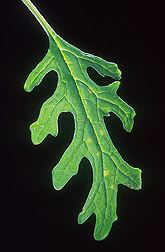This page has been archived and is being provided for reference purposes only. The page is no longer being updated, and therefore, links on the page may be invalid.
|
Read the magazine story to find out more. |
Researchers Battle Plum Pox in PennsylvaniaBy Jan SuszkiwSeptember 18, 2001 Near historic Gettysburg, Pa., federal and state scientists are facing down a different kind of threat than that once posed by General Robert E. Lee’s Confederate troops: an exotic stonefruit disease called plum pox that’s invaded orchards in Pennsylvania’s Adams, Cumberland and York counties. When and how it arrived there--possibly from Europe--remains speculative. Fortunately, even before its U.S. presence was announced in October 1999, U.S. Department of Agriculture scientists had already begun researching the disease in anticipation of its arrival. Soon after the announcement, they teamed with scientists from the Pennsylvania Department of Agriculture and Pennsylvania State University to better tackle this new threat to the nation’s $1.8 billion stonefruit industry. Through research on six basic fronts, including identification of aphid carriers and herbaceous weed reservoirs, they’re helping to eradicate plum pox from the affected counties and devise strategies by which U.S. orchard managers can cope with the disease should it recur elsewhere, according to Vernon Damsteegt, a plant pathologist with USDA’s Agricultural Research Service. Plum pox poses no danger to consumers. But it can ruin the marketability of plums, peaches, apricots and other stonefruits by causing acidity and deformities. Adams, Cumberland, and York counties in Pennsylvania are the only U.S. locations where plum pox (strain D) has been reported. Since spring 2000, Pennsylvania researchers have been surveying orchards in the affected and neighboring counties to determine which aphid species occur there. At ARS’ Foreign Disease-Weed Science Research Unit in Fort Detrick, Md., Damsteegt and PSU scientist Frederick Gildow test the aphids to determine which actually transmit plum pox to plants. One confirmed accomplice is the green peach aphid. Meanwhile, ARS horticulturist Ralph Scorza in Kearneysville, W.Va., is checking the susceptibility of native and ornamental Prunus species. Both studies will help scientists find, and break, weak links in the plum pox disease cycle, as well as monitor any possible spread to woodland areas or gardens. A longer story in in the September issue of Agricultural Research magazine. The research is part of the ARS National Program on plant diseases. |


